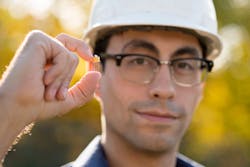Q&A: How can the industry simplify water quality monitoring?
On April 27 during our live webinar, water quality experts from Crystal IS will help explain how UVC LEDs can improve and simplify water monitoring and provide real-time data. In this Q&A, the Crystal IS team shares a few details regarding what they will discuss during the live event, and why this technology is so important.
What are some challenges associated with traditional, water grab sampling?
Essentially this comes down to cost, integrity of the data and utility of the data. Kit and lab style grab sample testing can be expensive and come with sample integrity risks and potential errors in manual data collection. Perhaps of greater importance, a grab sample process only provides a periodic snapshot of process performance sometimes with data delayed for days in the lab. This may be fine for reporting but misses the opportunity to leverage the effort and investment for process control and productivity.
Explain some of the major water quality issues that the UVC LEDs can identify?
The growth of industrial effluent monitoring in developing nations, like India, combined with increasing and stricter regulatory requirements in developed nations, specifically demands for increased accuracy, specificity and test frequency are key drivers for water quality monitoring. UVC LED optical sensors can identify specific organics and other key molecules down to parts-per-billion levels and provide the durability, lifetime and operational parameters for on-site monitoring.
What parameters can UVC LEDs monitor (what sensor types can be equipped with them)?
In water, UVC wavelengths can be immediately integrated into compliance and process monitoring for U.S. Environmental Protection Agency UV254, biochemical oxygen demand, chemical oxygen demand, total organic carbon, and others with industry and regulatory standardized testing parameters. UVC LEDs can be deployed in simple optical sensor systems to monitor critical organics, hydrocarbons, proteins, and a wide range of indicator compounds in food and beverage and pharmaceutical processes.
Is there anything else prospective webinar attendees should know about this technology?
UVC wavelengths have been critical for demanding, real-time data collection in water for many years. With several years of demonstrated capability, UVC LEDs are positioned to replace more and more grab sampling requirements in the industry.
We hope to be able to share even more during the webinar on April 27. For more details about the webinar, please watch the short video below. To register for the event, click here.
